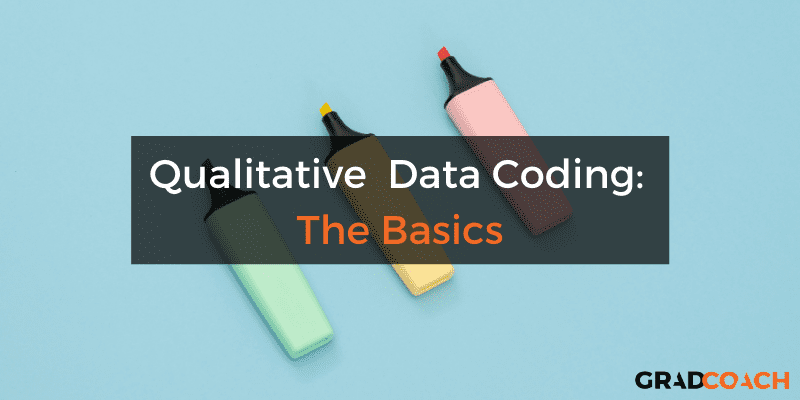
As we’ve discussed previously, qualitative research makes use of non-numerical data – for example, words, phrases or even images and video. To analyse this kind of data, the first dragon you’ll need to slay is qualitative data coding (or just “coding” if you want to sound cool). But what exactly is coding and how do you do it?
In this post, we’ll explain qualitative data coding in simple terms. Specifically, we’ll dig into:

Let’s start by understanding what a code is. At the simplest level, a code is a label that describes the content of a piece of text. For example, in the sentence:
“Pigeons attacked me and stole my sandwich.”
You could use “pigeons” as a code. This code simply describes that the sentence involves pigeons.
So, building onto this, qualitative data coding is the process of creating and assigning codes to categorise data extracts. You’ll then use these codes later down the road to derive themes and patterns for your qualitative analysis (for example, thematic analysis). Coding and analysis can take place simultaneously, but it’s important to note that coding does not necessarily involve identifying themes (depending on which textbook you’re reading, of course). Instead, it generally refers to the process of labelling and grouping similar types of data to make generating themes and analysing the data more manageable.
Makes sense? Great. But why should you bother with coding at all? Why not just look for themes from the outset? Well, coding is a way of making sure your data is valid . In other words, it helps ensure that your analysis is undertaken systematically and that other researchers can review it (in the world of research, we call this transparency). In other words, good coding is the foundation of high-quality analysis.

Now that we’ve got a plain-language definition of coding on the table, the next step is to understand what overarching types of coding exist – in other words, coding approaches. Let’s start with the two main approaches, inductive and deductive.
With deductive coding, you, as the researcher, begin with a set of pre-established codes and apply them to your data set (for example, a set of interview transcripts). Inductive coding on the other hand, works in reverse, as you create the set of codes based on the data itself – in other words, the codes emerge from the data. Let’s take a closer look at both.
With deductive coding, we make use of pre-established codes, which are developed before you interact with the present data. This usually involves drawing up a set of codes based on a research question or previous research . You could also use a code set from the codebook of a previous study.
For example, if you were studying the eating habits of college students, you might have a research question along the lines of
“What foods do college students eat the most?”
As a result of this research question, you might develop a code set that includes codes such as “sushi”, “pizza”, and “burgers”.
Deductive coding allows you to approach your analysis with a very tightly focused lens and quickly identify relevant data. Of course, the downside is that you could miss out on some very valuable insights as a result of this tight, predetermined focus.

But what about inductive coding? As we touched on earlier, this type of coding involves jumping right into the data and then developing the codes based on what you find within the data.
For example, if you were to analyse a set of open-ended interviews, you wouldn’t necessarily know which direction the conversation would flow. If a conversation begins with a discussion of cats, it may go on to include other animals too, and so you’d add these codes as you progress with your analysis. Simply put, with inductive coding, you “go with the flow” of the data.
Inductive coding is great when you’re researching something that isn’t yet well understood because the coding derived from the data helps you explore the subject. Therefore, this type of coding is usually used when researchers want to investigate new ideas or concepts, or when they want to create new theories.

If you’ve got a set of codes you’ve derived from a research topic, literature review or a previous study (i.e. a deductive approach), but you still don’t have a rich enough set to capture the depth of your qualitative data, you can combine deductive and inductive methods – this is called a hybrid coding approach.
To adopt a hybrid approach, you’ll begin your analysis with a set of a priori codes (deductive) and then add new codes (inductive) as you work your way through the data. Essentially, the hybrid coding approach provides the best of both worlds, which is why it’s pretty common to see this in research.
See how Grad Coach can help you.
Now that we’ve looked at the main approaches to coding, the next question you’re probably asking is “how do I actually do it?”. Let’s take a look at the coding process , step by step.
Both inductive and deductive methods of coding typically occur in two stages: initial coding and line by line coding .
In the initial coding stage, the objective is to get a general overview of the data by reading through and understanding it. If you’re using an inductive approach, this is also where you’ll develop an initial set of codes. Then, in the second stage (line by line coding), you’ll delve deeper into the data and (re)organise it according to (potentially new) codes.
Let’s take a look at these two stages of coding in more detail.
The first step of the coding process is to identify the essence of the text and code it accordingly. While there are various qualitative analysis software packages available, you can just as easily code textual data using Microsoft Word’s “comments” feature.
Let’s take a look at a practical example of coding. Assume you had the following interview data from two interviewees:
What pets do you have?
I have an alpaca and three dogs.
Only one alpaca? They can die of loneliness if they don’t have a friend.
I didn’t know that! I’ll just have to get five more.
What pets do you have?
I have twenty-three bunnies. I initially only had two, I’m not sure what happened.
In the initial stage of coding, you could assign the code of “pets” or “animals”. These are just initial, fairly broad codes that you can (and will) develop and refine later. In the initial stage, broad, rough codes are fine – they’re just a starting point which you will build onto in the second stage.

But how exactly do you decide what codes to use when there are many ways to read and interpret any given sentence? Well, there are a few different approaches you can adopt. The main approaches to initial coding include:
Let’s take a look at each of these:
When you use in vivo coding, you make use of a participants’ own words , rather than your interpretation of the data. In other words, you use direct quotes from participants as your codes. By doing this, you’ll avoid trying to infer meaning, rather staying as close to the original phrases and words as possible.
In vivo coding is particularly useful when your data are derived from participants who speak different languages or come from different cultures. In these cases, it’s often difficult to accurately infer meaning due to linguistic or cultural differences.
For example, English speakers typically view the future as in front of them and the past as behind them. However, this isn’t the same in all cultures. Speakers of Aymara view the past as in front of them and the future as behind them. Why? Because the future is unknown, so it must be out of sight (or behind us). They know what happened in the past, so their perspective is that it’s positioned in front of them, where they can “see” it.
In a scenario like this one, it’s not possible to derive the reason for viewing the past as in front and the future as behind without knowing the Aymara culture’s perception of time. Therefore, in vivo coding is particularly useful, as it avoids interpretation errors.
Next up, there’s process coding, which makes use of action-based codes . Action-based codes are codes that indicate a movement or procedure. These actions are often indicated by gerunds (words ending in “-ing”) – for example, running, jumping or singing.
Process coding is useful as it allows you to code parts of data that aren’t necessarily spoken, but that are still imperative to understanding the meaning of the texts.
An example here would be if a participant were to say something like, “I have no idea where she is”. A sentence like this can be interpreted in many different ways depending on the context and movements of the participant. The participant could shrug their shoulders, which would indicate that they genuinely don’t know where the girl is; however, they could also wink, showing that they do actually know where the girl is.
Simply put, process coding is useful as it allows you to, in a concise manner, identify the main occurrences in a set of data and provide a dynamic account of events. For example, you may have action codes such as, “describing a panda”, “singing a song about bananas”, or “arguing with a relative”.

Descriptive coding aims to summarise extracts by using a single word or noun that encapsulates the general idea of the data. These words will typically describe the data in a highly condensed manner, which allows the researcher to quickly refer to the content.
Descriptive coding is very useful when dealing with data that appear in forms other than traditional text – i.e. video clips, sound recordings or images. For example, a descriptive code could be “food” when coding a video clip that involves a group of people discussing what they ate throughout the day, or “cooking” when coding an image showing the steps of a recipe.
Structural coding involves labelling and describing specific structural attributes of the data. Generally, it includes coding according to answers to the questions of “ who ”, “ what ”, “ where ”, and “ how ”, rather than the actual topics expressed in the data. This type of coding is useful when you want to access segments of data quickly, and it can help tremendously when you’re dealing with large data sets.
For example, if you were coding a collection of theses or dissertations (which would be quite a large data set), structural coding could be useful as you could code according to different sections within each of these documents – i.e. according to the standard dissertation structure . What-centric labels such as “hypothesis”, “literature review”, and “methodology” would help you to efficiently refer to sections and navigate without having to work through sections of data all over again.
Structural coding is also useful for data from open-ended surveys. This data may initially be difficult to code as they lack the set structure of other forms of data (such as an interview with a strict set of questions to be answered). In this case, it would useful to code sections of data that answer certain questions such as “who?”, “what?”, “where?” and “how?”.
Let’s take a look at a practical example. If we were to send out a survey asking people about their dogs, we may end up with a (highly condensed) response such as the following:
Bella is my best friend. When I’m at home I like to sit on the floor with her and roll her ball across the carpet for her to fetch and bring back to me. I love my dog.
In this set, we could code Bella as “who”, dog as “what”, home and floor as “where”, and roll her ball as “how”.
Finally, values coding involves coding that relates to the participant’s worldviews . Typically, this type of coding focuses on excerpts that reflect the values, attitudes, and beliefs of the participants. Values coding is therefore very useful for research exploring cultural values and intrapersonal and experiences and actions.
To recap, the aim of initial coding is to understand and familiarise yourself with your data , to develop an initial code set (if you’re taking an inductive approach) and to take the first shot at coding your data . The coding approaches above allow you to arrange your data so that it’s easier to navigate during the next stage, line by line coding (we’ll get to this soon).
While these approaches can all be used individually, it’s important to remember that it’s possible, and potentially beneficial, to combine them . For example, when conducting initial coding with interviews, you could begin by using structural coding to indicate who speaks when. Then, as a next step, you could apply descriptive coding so that you can navigate to, and between, conversation topics easily. You can check out some examples of various techniques here.
See how Grad Coach can help you.